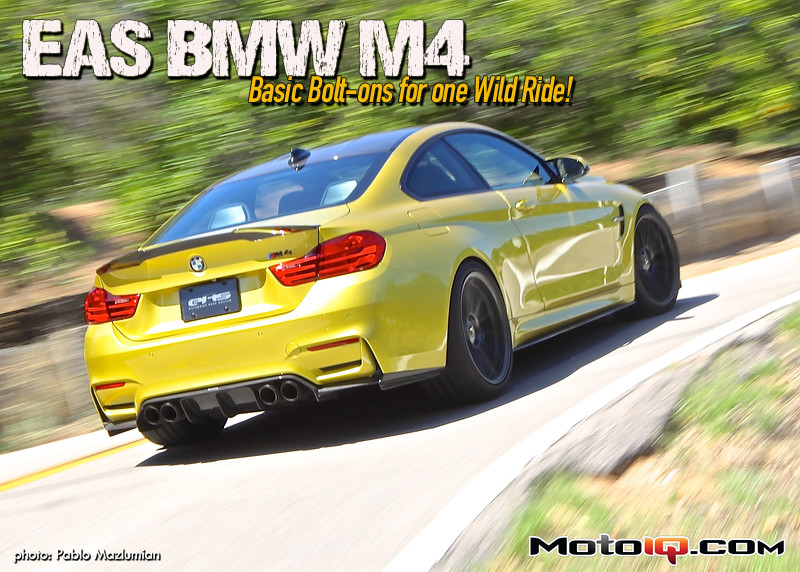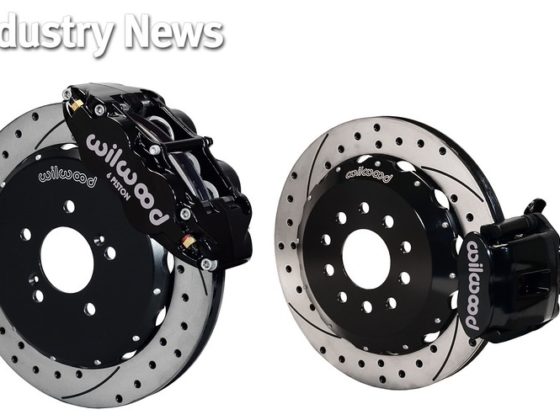
The EAS BMW M4 is a blast to drive. The 3.0-liter twin turbo power plant is torque-heaven, and the engine is most likely underrated from the factory. Today, we'll be showing you just how much faster the new M3 is versus the outgoing V8 M3 in detail, and also how EAS takes this car to the next level with some basic bolt-ons (as well as simple aesthetic upgrades). You'll see evidence in the dyno graphs and we'll also take you for a short ride with a video showing this BMW M4's acceleration!
EAS BMW M4: Basic bolt-ons for one wild ride!
I think I’m not alone when I say this, but I really wish the BMW M4 was called the M3 or M3 Coupe. This whole “M4” nomenclature is bizarre. Why not call the 4-door sedan the “M4” and the coupe the “M3”, since the original E30 and E36s M3s started as coupes? It would also be easier to remember the “M4” as being the sedan, wouldn't it? I know it's about the sedans being the odd numbers and keeping the coupes even numbered, but man! And then you’ve got the chassis codes, which are:
F80: BMW M3 (sedan)
F82: BMW M4 (coupe)
F83: BMW M4 Convertible (it’s an M4 since it’s a coupe)
Maybe it’s a German thing. As a group, let’s go ahead and call these the F8X M3/M4.
In any case, all is forgiven when we realize that these Germans know how to build cars, plain and simple. The BMW F8X M3/M4s are phenomenal out of the box. We spent some time in an F82 BMW M4 built by EAS, and we’ll showcase a few notable features on this particular car, on top of its stout performance.
Speaking of performance, this BMW M4 is unbelievable. But I'm thankful to live in the United States, which is full of aftermarket tuning companies still willing to take cars like these to the next level.
European Auto Source (EAS) is one of those outfits. Based in Southern California, EAS sells and installs a plethora of BMW aftermarket tuning parts. The firm seems to specialize in the smaller 3 Series-like BMWs (because in this family of cars you can also now include 1-, 2- and 4-Series BMWs), although the occasional E60 or F10 M5 will swing by EAS' shop as well.
The guys at EAS and I go way back—shoot, it’s around 14 years now. Co-owner Steve Lee had worked on several of my previous project cars when he was working for another outfit, which has since closed its doors. What he and co-owner Tom Guagliardo have done over the past decade with EAS is remarkable. Today, EAS has a huge following, and it's always one of the first shops in the area to get a newly released BMW from the dealership so they can start their magic.
Currently, EAS is probably more widely known for the 100-plus supercharged V8 E90/E92 M3s that are rolling around the southland, scaring Vipers and Porsches (more on that on Page 11). But, as expected, as soon as BMW released the F8X cars, EAS was ready and waiting. They picked up this M4 from the local dealer and right away started working with ESS Tuning–a well known BMW tuner from Norway–to get good, reliable power from their software upgrade while chugging the cruddy 91-octane fuel, which unfortunate California residents are limited to.

If you compare an M4 (coupe) to an M3 (sedan), the coupe has a sleeker, longer look. This M4 featured today sports Vorsteiner parts that we’ll get more into detail shortly. But what do you think of the color? This is BMW's new “Austin Yellow”.
When the E46 M3 was released in 2001, it was offered in a similar color known as “Phoenix Yellow,” which was initially unpopular. In fact, Phoenix Yellow was known as “puke yellow” to many enthusiasts in the BMW community. Today, however, some people seem to be upping their resale prices because of this very color (this also happened to the once-unpopular Byzanz color with the E36 M3, although that color is more rare).

Living in Kansas City now for the past 10 years, I return to California once or twice a year to see family, and I’m always excited to visit EAS when I can. On any given day, the shop has an assortment of BMW M3 and M4s they’re working on. On this trip I walked in to see—from left to right—an F80 BMW M3, an F82 BMW M4, another F82 BMW M4, and then finally an E90 BMW M3 sedan (the M3 coupe chassis was the E92).
Before we take a look at the EAS BMW M4 car, there is something you need to understand, and that is BMW is most likely sandbagging its numbers. This new F8X M3/M4 is way ahead of its predecessor, the E9X M3. Let me explain:
The new 3.0-liter turbo M3/M4 cars are rated at 425bhp while the outgoing E9X 4.0-liter V8 M3s were rated at 414bhp from the factory. However, the small gap is very deceiving. While the outgoing cars tested around 114 MPH at the quarter, these new suckers are crossing the finish line at around 119 MPH! Now, come on. Would you expect a trap speed like that by a “425 BHP” car weighing 3600-lb? I don’t think so.
I think this habit of underrating power started in 2007 with the BMW 335i. It's rated at 300 BHP, and yet many examples have been dyno testing around 290 stock on a Dynojet, and some even more. Just this week, we even got to compare our upcoming Project BMW 335i (which is stock except for a K&N air filter) to our 320 WHP Project E46 M3. Would you believe the 335–an automatic, mind you–was only a car length behind to 100 MPH? 300 “BHP”…yeah, right.



